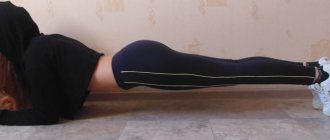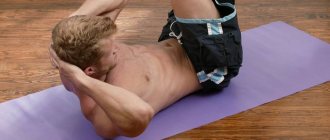A sporty, athletic figure with defined muscles will never go out of fashion and will always be in trend, and a toned stomach with pronounced “cubes” will decorate any body, making it aesthetically pleasing.
If we talk about health benefits, the abdominal muscles create a protective corset for our internal organs, and by doing exercises for this muscle group, we strengthen our spine from the inside.
In addition, strong abs are vital in all sports.
This article will provide a brief overview of several exercises for the abdominal muscles using kettlebells and discuss their simplest options. In the future, I will give a more detailed description of each of them about different techniques and ways to perform them.
How effective are exercises with weights for pumping up the abs?
Kettlebell exercises are a type of strength training. They help pump up the rectus and oblique abdominal muscles and dry out. Kettlebell abdominal exercises are effective when repeated regularly. If the exercise machine goes up once a month and collects dust the rest of the time, then there will be neither six-pack abs nor a flat stomach.
Achieving what you want is easier with weights than in the gym. The complex includes exercises with a large swing amplitude, for example, swinging your arms up and down. Movement requires energy and endurance. Several muscle groups are involved in the work, not only the abs, but also the biceps, triceps, back, and chest.
The kettlebell has thick handles. It's comfortable and helps strengthen your hands. Alternatively, you can use dumbbells, but there is a risk of dropping them.
You shouldn't expect quick results. Changes depend on your current level of fitness and endurance. In general, after 2-3 months of abdominal exercises you will notice:
- improving the body's endurance;
- strengthening the abdominal muscles and the whole body;
- a surge of strength, energy, motivation;
- the appearance of traces of future cubes.
KettlCross – functional training system with kettlebells
Content
Any activity sooner or later leads to the systematization of existing knowledge and skills in a particular area. Physical exercises with certain sports equipment are no exception.
Systematization means the collection and use of knowledge and skills in order to achieve certain sports results. In sports, this means successful performance in various kinds of tournaments. In fitness - body building and health promotion.
In the process of kettlebell lifting, I more than once had the idea of adapting kettlebell training in relation to fitness. This is how the idea of KettlCross arose - a system of training with kettlebells aimed at developing all major muscle groups, strengthening joints and ligaments, and strengthening the cardiovascular system of those involved.
In addition, due to the specifics of use, exercises with a kettlebell are highly effective cardio, which allows you to use this equipment for training in fat burning mode.
As has already been mentioned several times, the kettlebell is a very versatile sports equipment, which, due to some of its features (displaced center of gravity), allows you to work out the main muscle groups very effectively.
In addition, due to the specifics of use, exercises with a kettlebell are highly effective cardio, which allows you to use this equipment for training in fat burning mode. Another advantage of training with a kettlebell is the ability to use high-intensity exercises, which allows you to train the functional systems of the body.
So, as you can see, using kettlebells in the training process has many advantages.
All that remains is to systematize possible exercises in order to use them most effectively in the training process.
KettlCross is a kettlebell training system based on the development of training programs depending on the needs of the trainee.
The development of training programs is based on the principle of choosing exercises, alternating exercises, recommendations
according to the intensity of the exercises, the number of approaches performed in an exercise, the rest interval between exercises in an approach and approaches, depending on the needs of the practitioner.
Examples of training programs.
1. Cardio-KettlCross.
For cardio training, exercises are used that are aimed at working out the main large muscle groups, performed at an average level of intensity (HR – 130-160 beats per minute).
- Trasrer with a kettlebell - squats with a kettlebell on the chest, followed by standing up and pressing (shvung) the kettlebell up above your head.
- Kettlebell swing – high (kettlebell overhead) kettlebell swing from the saddle.
- Burpees with weights - push-ups on weights followed by jumping with weights in hands or throwing weights onto the chest and pushing (pressing, pushing) the weights up.
- Full Kettlebell Sit-Up – A sit-up using a kettlebell, complicated by standing up and swinging the kettlebell.
- Sumo squats with a kettlebell to the chin.
- Jumping (stepping) onto a pedestal with a kettlebell swing - classic jumping on a pedestal, used in CrossFit, complicated by swinging a kettlebell after jumping.
- Burpee with jumping (stepping) onto a stand and swinging a kettlebell.
- Execution speed is average.
- Number of approaches – 6 – 8.
- The number of repetitions per approach is 12 – 15.
- Rest between sets – 1 – 1.5 minutes.
To assess the required intensity of exercise, I recommend measuring heart rate after the 3rd and 6th approaches.
The weight of the kettlebell must be selected taking into account the level of fitness of the trainee. For beginners, this is a kettlebell of 4-6 kilograms for girls and 12-14 kilograms for men. These exercises are used both independently and in complexes.
Functional KettlCross.
For training in this area, complexes are used, usually consisting of several exercises that work different muscle groups.
Exercises are performed with a high degree of intensity. The primary indicator of intensity is heart rate.
To train functional capabilities, the trainee's pulse must go beyond 160 beats per minute. I recommend not exceeding the training intensity more than 180-190 beats per minute in the short-term range.
Functional training exercises are usually performed in 4-6 approaches in a circular system with a rest of 30-45 seconds between circles.
The weight of the kettlebell must be selected taking into account the level of fitness of the trainee.
To train functional capabilities, it is necessary to create a so-called recovery deficit for the body. In other words, it is necessary to start each subsequent circle against the background of under-recovery after the previous one. A rest interval of 30-45 seconds, provided that the complex exercises are performed at a high intensity, creates the necessary reserve of that same under-recovery. Kettlebell weight recommendations are similar to those described above for cardio training.
FUNCTIONAL TRAINING COMPLEX WITH Kettlebell
- Kettlebell swing. 20-25 reps.
- Pull-ups on the bar. 10-15 reps.
- Kettlebell push-ups. 10-15 reps.
- Burpee with kettlebell swing. 10-15 reps.
- Sit-up with a kettlebell. 10-15 reps.
Number of circles – 4-6. Rest between circles – 30-45 seconds.
3. Power KettlCross.
Training in this direction is characterized by low intensity, relatively small volume and large weight (if necessary) of kettlebells.
The principle of constructing a training complex is similar to the classical principle in fitness.
This is a small number of approaches - 3-4. The number of repetitions per approach is 6-8.
Despite its unusual shape for classic sports equipment in fitness (barbell, dumbbells), the kettlebell can be successfully used to perform such classic exercises as various presses and deadlifts. In addition, thanks to the shifted center of gravity, the use of a kettlebell allows you to create additional load when performing a particular exercise.
Below are exercises with a kettlebell that can be successfully used to develop and strengthen muscles.
- Bench/incline kettlebell press.
- Dumbbell flyes lying down/on an incline bench. 3. Seated biceps curl.
- Standing/seated kettlebell press. 5. Kettlebell row to the chin while standing.
- Sumo squats with a kettlebell.
- Kettlebell squats with emphasis on one leg.
- Calf raises with kettlebells.
Due to the specific shape of the kettlebell, for ease of use when performing individual exercises, I recommend holding the kettlebell in your hand as follows: the bow of the kettlebell is located in the palm diagonally from the base of the index finger to the base of the palm. So, as you can see, KettlCross is a fairly effective system of kettlebell exercises. This system can be successfully used both for training amateurs and for training professional athletes in various sports.
Such, for example, as martial arts, hockey, volleyball, handball, tennis, cycling, swimming, etc. In fact, training with a kettlebell is successfully suitable for athletes of cyclic sports, martial arts athletes and gamers.
With a competent approach to drawing up the KettlCross program, training with a kettlebell will give a tangible result in an increase in strength or functional indicators.
0 0 vote
Article rating
Exercises for women
Women's strength fitness has nuances. In this regard, questions arise about what weights to take, will I pump my shoulders with a kettlebell to the level of Arnold Schwarzenegger? With male bodybuilding, everything is clear - eat healthy food and increase the load as you get used to it. The situation is different with women. If you want to lose weight, get rid of fat on your stomach and sides, then you should not lift heavy weights. A cardio set of exercises with a kettlebell is suitable. Do as many repetitions as possible in one set, and try not to rest for more than 1 minute.
Girls strive to become owners of a thin waist. And abdominal exercises with weights make it wider and “meatier”. For abdominal muscles, do not use heavy weights.
Cardio exercises are considered effective for losing weight in the stomach and sides. To perform the complex you will need 2 weights weighing up to 5 kilograms, rhythmic, incendiary music and a tracksuit. Turn on the audio player, make rhythmic movements with your arms and legs to the beat of the music, and start squatting with a weight. To lose weight, rest for no more than 60 seconds. Start with 15 minutes of warm-up a day.
After a cardio shake-up, the abdominal muscles will warm up and can be flexed. For women, curling with a kettlebell is suitable:
- Stand up straight.
- Grasp the weight with your hands.
- Hold it at chest level.
- Start doing crunches.
- Keep your torso still.
We recommend reading
- Workouts with a jump rope for losing weight on the stomach and sides
- Exercises for losing weight on the abdomen and sides at home and in the gym
- Effective chair exercises to help burn belly fat
Squat swings
In order to pump up the upper limbs, the muscles of the shoulder girdle, and place feasible loads on the back and buttocks, perform kettlebell swings with a squat. Grab the handle of the projectile with both palms. Do a small squat, first placing your feet at shoulder level. Bring the weight between your legs, and then smoothly move the weight to an overhead position, describing a wide semicircle with outstretched arms. At the same time, straighten your lower limbs at the knees. Lower the weight to the starting position. While performing the exercise, try to do everything by inertia, do not slouch your back, and do not overexert your muscles.
Exercises for men
Exercises with weights for the body and abs are suitable for those men who want to pump up their entire body and become stronger.
The whole complex, which includes not only exercises for the abs, but also for other parts. Everyone chooses the number of approaches and repetitions independently. It depends on your level of physical fitness. For beginners, we advise you to do 8 times in 3 approaches.
No. 1 Standing interceptions
Take the weight in one hand and bring it behind your back. Pass the machine from behind to the other limb, which now needs to be moved forward in front of you. Transfer the tool from one brush to another. Perform the task for 30 seconds in one direction, and then the same amount in the opposite direction.
No. 2 Interceptions
Take a standing position with your legs wide apart, place your hand with the kettlebell between them from behind and grab it. Repeat the exercise on one side for half a minute, change hands and continue for 30 seconds. As you bend over to intercept, tighten your abdominal muscles, taking the strain off your back.
#3 Knee lift
Press the kettlebell up, lower it down to the side and at this moment lift your leg bent at a right angle. Right hand - right foot. Try to pull your knee towards your elbow. The position of the torso should remain straight. While performing the task, you should feel the oblique muscles tense. The entire body weight moves to the opposite leg. Repeat the workout for 30 seconds on each side.
No. 4 Turns
Stand straight, grab the bottom of the weights with your hands and place them at chest level. Turn your body right and left. The hips remain motionless, the stomach and upper part work. With the help of this exercise you can pump up the oblique abdominal muscles.
#5 Transfer
Sit on the floor, cross your legs and raise them. With your hands, grab the handle above the kettlebell and place it on your right side on the floor. Immediately lift the weight and move it to the left. During work, you feel a lot of tension, your stomach burns inside, which helps you quickly remove fat. This task helps to pump up the oblique muscle area.
No. 6 Static exercise with a 16 kg kettlebell for abs and relief
Place the machine on the floor upside down and support yourself. Stretch your torso in one line, as if doing push-ups. Tighten your midsection and hold this pose for 1 minute. Maintain balance, do not bend or stick your buttocks up.
Jump Squat
For the second exercise in your kettlebell circuit training, use jump squats. Place the exercise equipment on the floor. Perform a lying position. With straight arms, lean on the body of the weight. Stretch your body straight. Maintain balance through quality tension in your core muscles. Jump your legs towards the weights, which will allow you to move into a squat. The feet should be at shoulder level. Do not remove your palms from the weights, maintaining support. From this position, lift the sports equipment with outstretched arms strictly in a vertical plane. Keep your body at an angle of approximately 45° relative to the floor. Then slowly lower the weight back down. Throw your legs back, taking the original position with support while lying down. Do a series of these exercises.
Rules for performing exercises to reduce belly fat
Warm up before you start. Joint gymnastics, jumping and running in place are suitable.
Each subsequent approach should begin after a pause of 15-20 seconds.
If there is no other physical activity, then exercises for the abdominal muscles with weights should be performed up to 3-5 times a week.
How to remove fat deposits using home exercises and achieve effectiveness? Follow these rules:
- Gradual increase in loads. This is the main factor in all training. Beginners are prohibited from immediately starting gymnastics with a weight of 16 kg. It is important to gradually progress in weights, starting small. The body will gradually adapt, and you will become stronger and more prominent. This is the only way to pump up your stomach and accelerate muscle growth.
- Watch your diet. You won't be able to lose body fat and build a powerful body if you don't consume protein. You can't starve, but you can't overeat either. Proper, high-quality nutrition together with weights will help you achieve your goal in a short time. Forget about French fries, hamburgers, love vegetables, fruits, chicken breast and other dietary, but very tasty foods.
- Complete rest. Athletes know that good sleep is invaluable for effective training. You can do the 16-kilogram belly exercise every day, but you won’t achieve results if you don’t rest. When lifting weights, muscle cells are destroyed and the body experiences enormous stress. You can recover and become stronger only with the help of subsequent rest.
If you decide to develop your own complex on how to pump up your abs with kettlebells and remove extra centimeters, then be sure to include tasks for working out all sections of the middle part. Don't forget about the exercises to work on the oblique muscles. They will help make your body beautiful and strong.
Training program for beginner weightlifters
Warm up - 15 minutes. It includes running, general physical exercise (general physical exercise) and warm-up with weights.
- Classic clean and jerk, 8-10 sets of 10-12 lifts (4 minutes of walking around the gym instead of rest);
- Classic light kettlebell snatch, 2 sets of 80 - 90% of the maximum with each hand.
- Deadlift, 3 sets of 50% of what you can lift 12 - 16 times.
- Walking through gymnastic apparatus, 1 approach to 3–5 apparatus according to your well-being.
Cross-country or jogging, you can also train on a treadmill, but with variations in the speed and incline of the track - 30 minutes.
Warm up - 15 minutes.
- Snatch of one competitive kettlebell 10 sets of 10 - 15 times with each hand (rest 4 minutes);
- Snatch of a lighter kettlebell 1 set to the maximum;
- Classic push-and-pull 3 sets of 12-16 times (4 minutes of walking around the gym instead of resting).
- Sitting on a bench, press kettlebells or barbells for 3 approaches 12–14 times, weight 30–50% of the maximum;
- Walking through gymnastic apparatus, 1 approach to 3–5 apparatus according to your well-being.
Swimming or football - 60 minutes.
Warm up 15 minutes.
- Classic clean and jerk, 10 sets of 12 - 16 reps (3.5 minutes of walking around the gym between sets);
- Light kettlebell snatch, 2 sets 80–90% of max with each arm.
- Jumping with a barbell on the shoulders, 3 sets of 30 jumps with a weight of 50% of the maximum;
Cross – half an hour.
What should you consider during training?
Stand "Swallow"
Perform balance exercises, as well as isometric tension of the abdominal muscles, lower and upper extremities. Bring your feet together. Bend over and grab the handle of the kettlebell with both palms. Bend so that a right angle is formed between your legs and body. Hold the weight freely, relaxing your arms. Bring your left leg back to a position parallel to the floor, leaning only on your right limb. Fix in a static position for a couple of seconds. Then perform a change of legs. Carry out the training for a minute, alternating support on the lower limbs.










